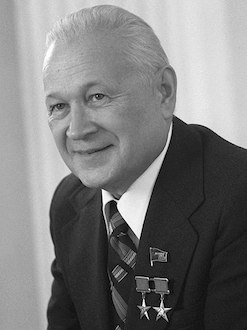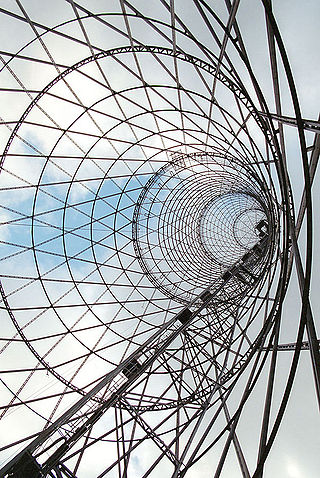NATO uses a system of code names, called reporting names, to denote military aircraft and other equipment used by the post-Soviet states, former Warsaw Pact countries, China, and other countries. The system assists military communications by providing short, one or two-syllable names, as alternatives to the precise proper names – which may be easily confused under operational conditions or are unknown in the western world.

Artem (Artyom) Ivanovich Mikoyan was a Soviet Armenian aircraft designer, who cofounded the Mikoyan-Gurevich design bureau along with Mikhail Gurevich.

An interceptor aircraft, or simply interceptor, is a type of fighter aircraft designed specifically for the defensive interception role against an attacking enemy aircraft, particularly bombers and reconnaissance aircraft. Aircraft that are capable of being or are employed as both ‘standard’ air superiority fighters and as interceptors are sometimes known as fighter-interceptors. There are two general classes of interceptor: light fighters, designed for high performance over short range; and heavy fighters, which are intended to operate over longer ranges, in contested airspace and adverse meteorological conditions. While the second type was exemplified historically by specialized night fighter and all-weather interceptor designs, the integration of mid-air refueling, satellite navigation, on-board radar and beyond visual range (BVR) missile systems since the 1960s has allowed most frontline fighter designs to fill the roles once reserved for specialised night/all-weather fighters.

Tupolev, officially Joint Stock Company Tupolev, is a Russian aerospace and defence company headquartered in Basmanny District, Moscow.
The maiden flight, also known as first flight, of an aircraft is the first occasion on which it leaves the ground under its own power. The same term is also used for the first launch of rockets.

Moscow Aviation Institute (National Research University) (MAI; Russian: Московский авиационный институт, МАИ) is one of the major engineering institutes in Moscow, Russia. Since its inception MAI has been spearheading advances in aerospace technology both within Russia and worldwide. The university laid emphasis on laboratory instruction in applied science and engineering, specific to the demands of aerospace industry.

Vladimir Nikolayevich Chelomey or Chelomei was a Soviet engineer and designer in the missile program of the former Soviet Union. He invented the first Soviet pulse jet engine and was responsible for the development of the world's first anti-ship cruise missiles and the ICBM program of the Soviet Union such as the UR-100, UR-200, UR-500 and UR-700.

The Russian Air Force is a branch of the Russian Aerospace Forces, the latter being formed on 1 August 2015 with the merging of the Russian Air Force and the Russian Aerospace Defence Forces. The modern VVS was originally established on 7 May 1992 following Boris Yeltsin's creation of the Ministry of Defence. However, the Russian Federation's air force can trace its lineage and traditions back to the Imperial Russian Air Service (1912–1917) and the Soviet Air Forces (1918–1991).

A supersonic aircraft is an aircraft capable of supersonic flight, that is, flying faster than the speed of sound. Supersonic aircraft were developed in the second half of the twentieth century. Supersonic aircraft have been used for research and military purposes, but only two supersonic aircraft, the Tupolev Tu-144 and the Concorde, ever entered service for civil use as airliners. Fighter jets are the most common example of supersonic aircraft.
The PJSC United Aircraft Corporation (UAC) is a Russian aerospace and defense corporation. With a majority stake belonging to the Russian government, it consolidates Russian private and state-owned aircraft manufacturing companies and assets engaged in the manufacture, design and sale of military, civilian, transport, and unmanned aircraft. Its headquarters are in Krasnoselsky District, Central Administrative Okrug, Moscow.

The 6th Red Banner Leningrad Army of Air and Air Defence Forces is an Air Army of the Russian Aerospace Forces.

Science and technology in Russia have developed rapidly since the Age of Enlightenment, when Peter the Great founded the Russian Academy of Sciences and Saint Petersburg State University and polymath Mikhail Lomonosov founded the Moscow State University, establishing a strong native tradition in learning and innovation.

Aircraft manufacturing is an important industrial sector in Russia, employing around 355,300 people. The dissolution of the Soviet Union led to a deep crisis for the industry, especially for the civilian aircraft segment. The situation started improving during the middle of the first decade of the 2000s due to growth in air transportation and increasing demand. A consolidation programme launched in 2005 led to the creation of the United Aircraft Corporation holding company, which includes most of the industry's key companies.
Yefim Gordon is a Lithuanian aircraft photographer and author who specializes in Soviet aircraft and Russian aviation.

Reactive Scientific Research Institute was one of the first Soviet research and development institutions to focus on rocket technology. RNII developed the Katyusha rocket launcher and its research and development were very important for later achievements of the Soviet rocket and space programs.
This page is based on this
Wikipedia article Text is available under the
CC BY-SA 4.0 license; additional terms may apply.
Images, videos and audio are available under their respective licenses.
















